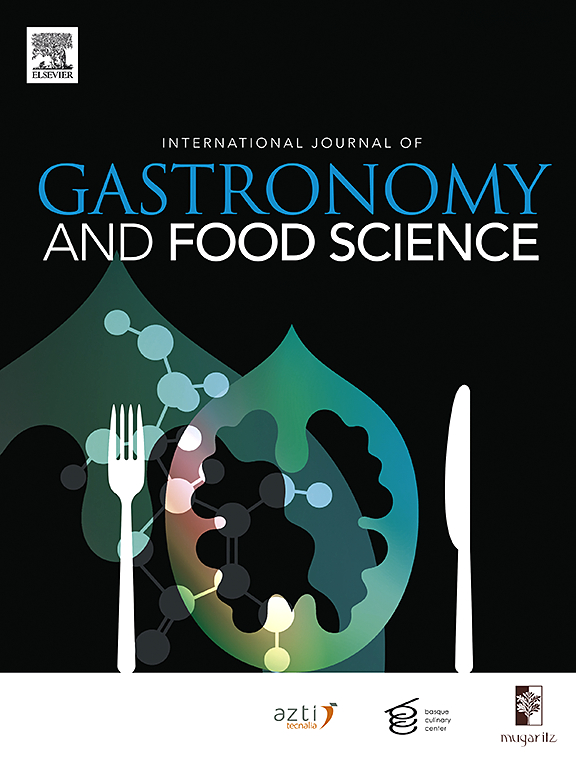The effect of different yeast and bacterial strain combinations on the physicochemical and metabolic profile of kombucha fermentation
IF 3.6
2区 农林科学
Q2 FOOD SCIENCE & TECHNOLOGY
International Journal of Gastronomy and Food Science
Pub Date : 2025-09-12
DOI:10.1016/j.ijgfs.2025.101296
引用次数: 0
Abstract
Kombucha is a beverage made by fermenting sweetened black tea with a Symbiotic Culture of Bacteria and Yeast (SCOBY). Most kombucha-related research uses a natural culture for the fermentation process, making it challenging to investigate the specific impacts of different strains on kombucha's fermentation. This study used three strains of acetic acid bacteria (AAB) and three strains of yeast. Three AAB strains (Komagataeibacter saccharivorans LYC1690, Komagataeibacter xylinus LYC1696, Komagataeibacter xylinus LYC1707) and three yeast strains (Zygosaccharomyces bailii LYC1691, Debaryomyces hansenii LYC1262, and Zygosaccharomyces bailii LYC1699) were combined into nine different fermentation processes. This study aims to investigate the impact of acetic acid bacteria and yeast on the fermentation process of kombucha. The investigation involved the determination of parameters, including pH value, acidity, color, total soluble solids, alcohol content, sugar, and organic acids. Principal Component Analysis (PCA) was used to examine metabolic trends. The results showed that yeast strains significantly influenced sucrose consumption, ethanol production, total soluble solids, and organic acid composition. Yeast strain 3 (Z. bailii LYC1699) showed the highest fermentative activity, producing increased ethanol, acetic acid, and malic acid levels while decreasing pH and TSS. In contrast, yeast strain 2 (D. hansenii LYC1262) was associated with increased gluconic and glucuronic acid levels, suggesting potential detoxification benefits. These findings highlight the importance of microbial selection in affecting kombucha's metabolic characteristics to produce novel flavors and functionality.
不同酵母菌和菌株组合对康普茶发酵理化和代谢特性的影响
康普茶是一种用细菌和酵母共生培养物(SCOBY)发酵加糖红茶制成的饮料。大多数与康普茶相关的研究使用自然培养进行发酵过程,这使得研究不同菌株对康普茶发酵的具体影响具有挑战性。本研究以3株醋酸菌(AAB)和3株酵母菌为研究对象。将3株AAB菌株(Komagataeibacter saccharivorans LYC1690、Komagataeibacter xylinus LYC1696、Komagataeibacter xylinus LYC1707)和3株酵母菌(Zygosaccharomyces bailii LYC1691、Debaryomyces hansenii LYC1262和Zygosaccharomyces bailii LYC1699)组合成9种不同的发酵工艺。本研究旨在探讨醋酸菌和酵母菌对康普茶发酵过程的影响。调查涉及参数的测定,包括pH值、酸度、颜色、总可溶性固形物、酒精含量、糖和有机酸。主成分分析(PCA)用于检查代谢趋势。结果表明,酵母菌株对蔗糖消耗量、乙醇产量、总可溶性固形物和有机酸组成有显著影响。酵母菌株3 (Z. bailii LYC1699)的发酵活性最高,其乙醇、乙酸和苹果酸含量均增加,pH和TSS均降低。相比之下,酵母菌株2 (D. hansenii LYC1262)与葡萄糖醛酸和葡萄糖醛酸水平升高有关,表明可能具有解毒作用。这些发现强调了微生物选择在影响康普茶代谢特性以产生新风味和功能方面的重要性。
本文章由计算机程序翻译,如有差异,请以英文原文为准。
求助全文
约1分钟内获得全文
求助全文
来源期刊

International Journal of Gastronomy and Food Science
Social Sciences-Cultural Studies
CiteScore
5.30
自引率
10.50%
发文量
170
审稿时长
45 days
期刊介绍:
International Journal of Gastronomy and Food Science is a peer-reviewed journal that explicitly focuses on the interface of food science and gastronomy. Articles focusing only on food science will not be considered. This journal equally encourages both scientists and chefs to publish original scientific papers, review articles and original culinary works. We seek articles with clear evidence of this interaction. From a scientific perspective, this publication aims to become the home for research from the whole community of food science and gastronomy.
IJGFS explores all aspects related to the growing field of the interaction of gastronomy and food science, in areas such as food chemistry, food technology and culinary techniques, food microbiology, genetics, sensory science, neuroscience, psychology, culinary concepts, culinary trends, and gastronomic experience (all the elements that contribute to the appreciation and enjoyment of the meal. Also relevant is research on science-based educational programs in gastronomy, anthropology, gastronomic history and food sociology. All these areas of knowledge are crucial to gastronomy, as they contribute to a better understanding of this broad term and its practical implications for science and society.
 求助内容:
求助内容: 应助结果提醒方式:
应助结果提醒方式:


